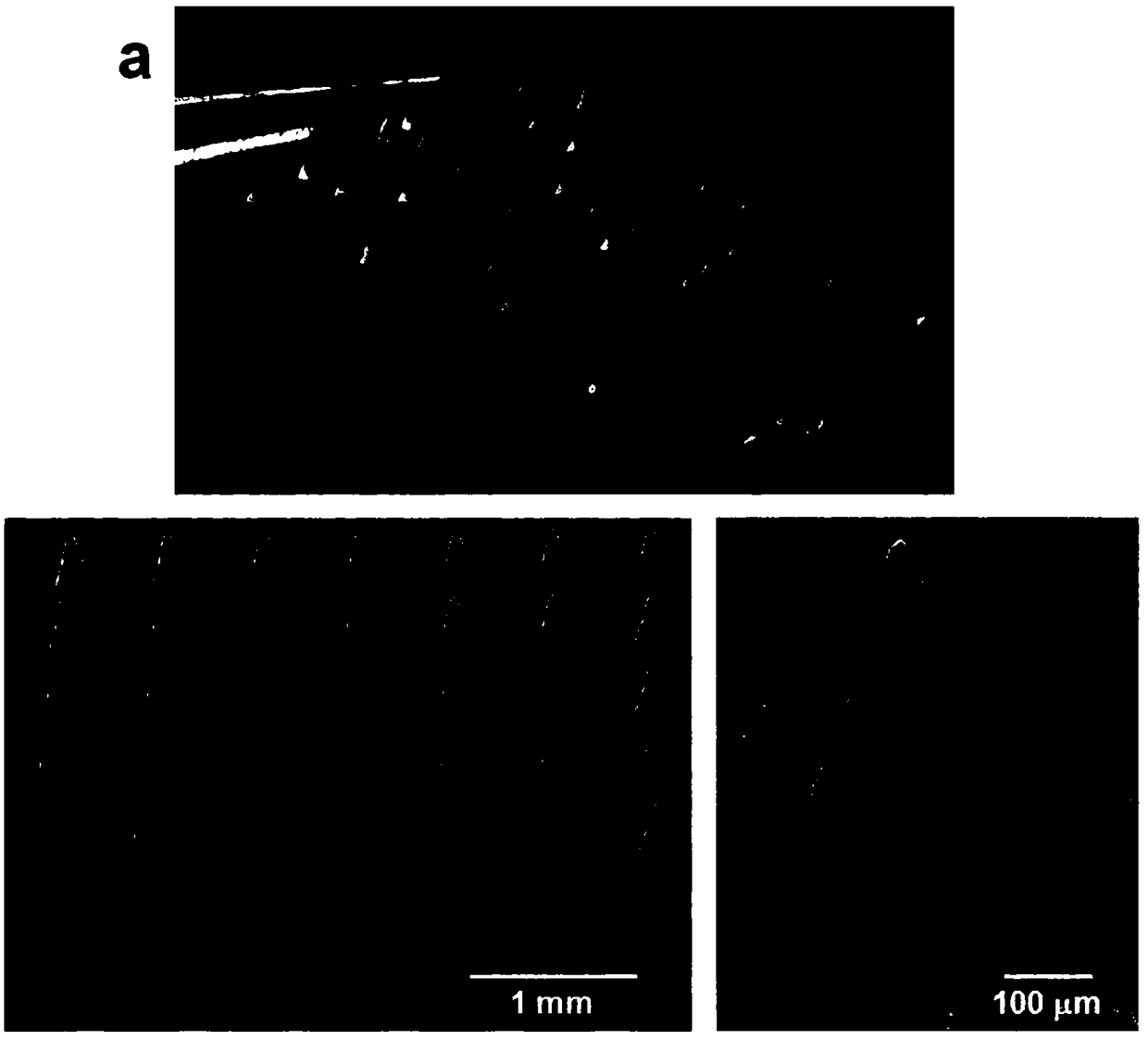3D printing microneedle patch for intelligent blood sugar regulation and a preparation method thereof
A 3D printing and intelligent adjustment technology, applied in the field of biomedicine, can solve problems such as the inability to achieve glucose levels, inconvenience for patients, and pain, and achieve the effects of intelligently adjusting blood sugar levels, reducing pain, and improving mechanical strength
- Summary
- Abstract
- Description
- Claims
- Application Information
AI Technical Summary
Problems solved by technology
Method used
Image
Examples
Embodiment 1
[0031] The preparation of the medicine of embodiment 1 intelligent regulation blood sugar
[0032] (1) According to the method described in the applicant's previous patent application "Gold Nanocluster Particles for Intelligently Released Insulin to Regulate Blood Sugar and Its Preparation Method" (Application No. 201810075085.8, Publication No. CN 108079282A) to prepare a smartly released insulin for regulating blood sugar Gold nanocluster particles (GNC-FPBA-Insulin or GNC-PBA-Insulin).
[0033] (2) Preparation of gold nanocluster particles (BSA-GNC-PBA-Insulin) responsive to blood glucose regulation
[0034] 1) Preparation of BSA-coated gold nanocluster particles (BSA-GNCs)
[0035] Contains HAuCl 4 . The BSA mixed solution was reacted at 35-40° C. for 10-18 h under the condition of pH ≥ 12 to obtain BSA-coated gold nanocluster particles (BSA-GNCs).
[0036] 2) Convert the amino groups on the surface of BSA to carboxyl groups
[0037]First add glutaraldehyde to the BSA-...
Embodiment 2
[0045] Example 2 Preparation and Application of Microneedle Patch for Smart Blood Sugar Regulation
[0046] (1) Modeling of 3D printed microneedle patches
[0047] Use modeling software (Solidworks or autoCAD, etc.) to build a three-dimensional model of the microneedle patch, and export it into an STL file format ( figure 1 a-b). Import the model into the printing software of the 3D printer and check the correction data.
[0048] The design and size of the three-dimensional model of the microneedle patch are as follows: figure 1 shown. The microneedle patch consists of two main parts, the substrate and the microneedle array. The microneedle array contains 11×11 conical structures ( figure 1 a-b), the diameter of each cone base is 300-400μm (d1), and the diameter of the cone top is 25μm (d2) (note: determined by the precision of SLA technology, its minimum resolution can only reach 25μm, and cannot reach smaller Size), the height is 600-800μm(h1), the distance between adj...
Embodiment 3
[0077] Example 3 Preparation and Application of Microneedle Patch for Intelligent Blood Sugar Regulation
[0078] In Example 2, the photosensitive material for preparing the microneedle patch by 3D printing is GelMA, and the photosensitive material for preparing the microneedle patch in this example is formylated hyaluronic acid (m-HA).
[0079] Hyaluronic acid is a natural polymer material with excellent biocompatibility. Formylated hyaluronic acid (m-HA) is a photosensitive biological hydrogel material obtained by reacting hyaluronic acid (HA) with methacrylic anhydride. Add N,N'-methylenebisacrylamide (MBA) and photoinitiator (I2959) to m-MA, and irradiate with ultraviolet light (365nm) for a certain period of time to undergo photocrosslinking and curing.
[0080] The specific method of 3D printing microneedle patch is as follows:
[0081] Prepare mass percentage 4% (2%-10%, preferably 4%) m-HA, 2% (2%-5%, preferably 2%) N,N'-methylenebisacrylamide (MBA) and 0.5% (0.05%-...
PUM
 Login to View More
Login to View More Abstract
Description
Claims
Application Information
 Login to View More
Login to View More - R&D
- Intellectual Property
- Life Sciences
- Materials
- Tech Scout
- Unparalleled Data Quality
- Higher Quality Content
- 60% Fewer Hallucinations
Browse by: Latest US Patents, China's latest patents, Technical Efficacy Thesaurus, Application Domain, Technology Topic, Popular Technical Reports.
© 2025 PatSnap. All rights reserved.Legal|Privacy policy|Modern Slavery Act Transparency Statement|Sitemap|About US| Contact US: help@patsnap.com



